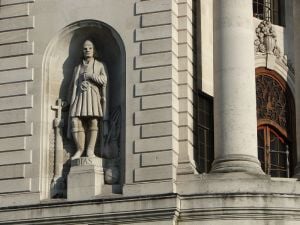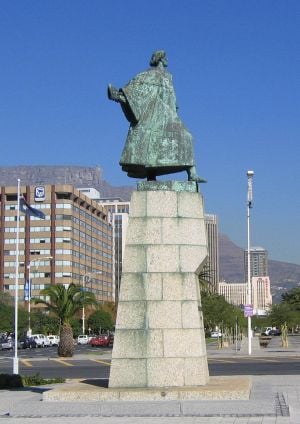Difference between revisions of "Bartolomeu Dias" - New World Encyclopedia
| Line 45: | Line 45: | ||
*Andrade, Sérgio C. [http://ml.ci.uc.pt/mhonarchive/archport/msg03260.html Destroços descobertos no Atlântico sul devem ser de barco português] Retrieved May 4, 2008. | *Andrade, Sérgio C. [http://ml.ci.uc.pt/mhonarchive/archport/msg03260.html Destroços descobertos no Atlântico sul devem ser de barco português] Retrieved May 4, 2008. | ||
*BBC News. [http://news.bbc.co.uk/2/hi/africa/7376259.stm Namibia finds treasure shipwreck] Retrieved May 1, 2008. | *BBC News. [http://news.bbc.co.uk/2/hi/africa/7376259.stm Namibia finds treasure shipwreck] Retrieved May 1, 2008. | ||
| − | |||
| − | |||
*[http://www.archaeolink.com/explorer_bartolomeu_dias.htm Explorer Bartolomeu Dias: List of relevant links] Retrieved August 20, 2008. | *[http://www.archaeolink.com/explorer_bartolomeu_dias.htm Explorer Bartolomeu Dias: List of relevant links] Retrieved August 20, 2008. | ||
*[http://www.nndb.com/people/593/000095308/ NNDB: Bartholomew Diaz Biography] Retrieved August 20, 2008. | *[http://www.nndb.com/people/593/000095308/ NNDB: Bartholomew Diaz Biography] Retrieved August 20, 2008. | ||
| Line 53: | Line 51: | ||
*[http://www.newadvent.org/cathen/04775b.htm Catholic Encyclopedia] Retrieved August 20, 2008. | *[http://www.newadvent.org/cathen/04775b.htm Catholic Encyclopedia] Retrieved August 20, 2008. | ||
*[http://www.elizabethan-era.org.uk/bartholomeu-dias.htm Bartholomeu Dias Facts and Short Biography] Retrieved August 20, 2008. | *[http://www.elizabethan-era.org.uk/bartholomeu-dias.htm Bartholomeu Dias Facts and Short Biography] Retrieved August 20, 2008. | ||
| − | + | ||
Revision as of 06:47, 23 August 2008
Bartolomeu Dias (pronounced [baɾtuluˈmeu ˈdiɐʃ]; Anglicized: Bartholomew Diaz) (c. 1450 – May 29, 1500), a Nobleman of the Royal Household, was a Portuguese explorer who sailed around the southernmost tip of Africa in 1488, the first European known to have done so.
Personal life
Dias was married and had two children:
- Simão Dias de Novais, who died unmarried and without issue
- António Dias de Novais, a Knight of the Order of Christ, married to (apparently his relative, since the surname de Novais was transmitted through her brother's offspring) Joana Fernandes, daughter of Fernão Pires and wife Guiomar Montês (and sister of Brites Fernandesand Fernão Pires, married to Inês Nogueira, daughter of Jorge Nogueira and wife, and had issue), and had issue.
Dias' grandson Paulo Dias de Novais was a Portuguese colonizer of Africa in the 16th century. Dias' granddaughter, Guiomar de Novais married twice, as his second wife to Dom Rodrigo de Castro, son of Dom Nuno de Castro and wife Joana da Silveira, by whom she had Dona Paula de Novais and Dona Violante de Castro, both died unmarried and without issue, and to Pedro Correia da Silva, natural son of Cristóvão Correia da Silva, without issue.
Travels
In 1481 Dias accompanied Diogo de Azambuja on an expedition to the Gold Coast. Dias was a cavalier of the royal court, superintendent of the royal warehouses and sailing-master of the man-of-war São Cristóvão (Saint Christopher). King John II of Portugal had appointed him on October 10, 1486 as the head of an expedition that was to endeavor to sail around the southern end of Africa in the hope of finding a trade route leading to Asia. Another important purpose of the expedition was to try to find the country of which recent reports had arrived through João Afonso de Aveiro and with which the Portuguese wished to enter into friendly relations.
Dias sailed, at first, towards the mouth of the Congo River, discovered the year before by Diogo Cão and Martin Behaim, then, following the African coast, he entered Walvis Bay. From 29° south latitude (Port Nolloth), he lost sight of the coast and was sailing south in a violent storm, which had lasted thirteen days. He did not know that he had sailed well beyond the tip of the continent. When calm weather returned he sailed in an easterly direction and, when no land appeared, turned northward, landing at the "Baía dos Vaqueiros" (Mossel Bay) on March 12, 1488.(Vasco da Gama landed at Mossel Bay on March 12, 1488.) Dias had rounded both the Cape of Good Hope and Cape Agulhas, the southernmost point of Africa without ever having been to them before.
Continuing east, he sailed as far as the Great Fish River. Once it had become clear that India could be reached by sailing north up the coast, he turned back. It was only on the return voyage that he discovered the Cape of Good Hope in May 1488. Dias returned to Lisbon in December 1488 after an absence of sixteen months and seventeen days. He had explored a total of about 2,030 km of unknown African coast.
He originally named the Cape of Good Hope the "Cape of Storms" (Cabo das Tormentas). It was later renamed by King John II of Portugal as the Cape of Good Hope (Cabo da Boa Esperança) because of the opening of a route to the east. The discovery of the passage around Africa was significant because for the first time Europeans could trade directly with India and the other parts of Asia, bypassing the overland route through of the Middle East, with its expensive middle men. The official report of the expedition to the Cape of Good Hope has been lost.
It appears that the Portuguese took a decade-long break from Indian Ocean exploration after Dias' return. In that hiatus, it is likely that they got valuable information from a secret agent, Pêro da Covilhã, who had been sent overland to India and provided valuable information useful to their ocean navigators.[1]
In 1497 Dias was posted in São Jorge da Mina Castle and accompanied Vasco da Gama's expedition to India. He followed Gama with one ship to Cape Verde. He also accompanied Pedro Álvares Cabral on the voyage that resulted in the discovery of Brazil in 1500. He died off the shore at the Cape of Good Hope when his vessel was wrecked in a storm.
In early 2008 Namdeb discovered an early 16th century wreck off the coast of Namibia. It was originally speculated that this might be the wreck of Dias' ship,[2] but the gold coins were identified as "Português" (also known as "Portugaloser") which were minted after 1525,[3] thus excluding the possibility of it being Dias' ship.
See also
- Pedro Álvares Cabral
- List of explorers
Notes
- ↑ David Fromkin, The Way of the World': From the Dawn of Civilizations to the Eve of the Twenty-First Century' (New York: Vintage Books, 2000), 117.
- ↑ BBC News, Namibia finds treasure shipwreck Retrieved May 1, 2008.
- ↑ Sérgio C. Andrade, Destroços descobertos no Atlântico sul devem ser de barco português Retrieved May 4, 2008.
ReferencesISBN links support NWE through referral fees
- Axelson, Eric. 1973. Congo to Cape; early Portuguese explorers. New York: Barnes & Noble. ISBN 9780064902526
- Axelson, Eric, C. R. Boxer, Graham Bell-Cross, and C. G. C. Martin. 1988. Dias and his successors. Cape Town: Saayman & Weber. ISBN 9780797100299
- Fromkin, David. 2000. The Way of the World: From the Dawn of Civilizations to the Eve of the Twenty-First Century. New York: Vintage Books. ISBN 0679766693
- Ravenstein, Ernest George. 1986. The voyages of Diogo Cão and Bartholomeu Dias, 1482-88. Pretoria: State Library. ISBN 9780798913300
- Reis, A. do Carmo. 1995. Bartolomeu Dias. Os mairores navegadores do mundo. Porto: Porto Editora. ISBN 9789720704214
External Links
- Andrade, Sérgio C. Destroços descobertos no Atlântico sul devem ser de barco português Retrieved May 4, 2008.
- BBC News. Namibia finds treasure shipwreck Retrieved May 1, 2008.
- Explorer Bartolomeu Dias: List of relevant links Retrieved August 20, 2008.
- NNDB: Bartholomew Diaz Biography Retrieved August 20, 2008.
- Epic Voyages: Bartholomeu Diaz Retrieved August 20, 2008.
- The Great Explorers: Bartholomeu Diaz Retrieved August 20, 2008.
- Catholic Encyclopedia Retrieved August 20, 2008.
- Bartholomeu Dias Facts and Short Biography Retrieved August 20, 2008.
Credits
New World Encyclopedia writers and editors rewrote and completed the Wikipedia article in accordance with New World Encyclopedia standards. This article abides by terms of the Creative Commons CC-by-sa 3.0 License (CC-by-sa), which may be used and disseminated with proper attribution. Credit is due under the terms of this license that can reference both the New World Encyclopedia contributors and the selfless volunteer contributors of the Wikimedia Foundation. To cite this article click here for a list of acceptable citing formats.The history of earlier contributions by wikipedians is accessible to researchers here:
The history of this article since it was imported to New World Encyclopedia:
Note: Some restrictions may apply to use of individual images which are separately licensed.

